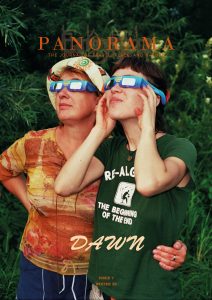“This is a very nice place,” said Aya, our Cambodian intern, one long breath after the big, red Rural bus dropped us off the highway in front of the Aleosan Public Market in North Cotabato.
As if reading my mind, she added, “It doesn’t look like a conflict area.”
I had to agree. Even I had been struck dumb by the rolling grass-green hills and the quiet, cool – dare I say peaceful – breeze of that early September morning.
Earlier that month, some of the folks from Balay Mindanaw, the nonprofit organization I worked for back then, were scheduled to come to Aleosan for a field visit. However, armed clashes in surrounding areas, as well as alleged rebel sightings within the town, had meant that the field visit was a no-go.
The situation had, supposedly, become “stable” just before we left, Aya to conduct an art workshop and I to write something for a book. Partially due to overthinking the definition of the word “stable,” I was all nerves during the trip. I was officially responsible for a foreign intern. It was tough to maintain composure when the thoughts going through my head went something like:
- Don’t sit under the luggage compartment because if someone happened to plant a bus bomb, they’d put it there.
- Who owns that bag in the compartment a few seats ahead? The man sitting under it got off two stops ago.
- If that creepy conductor tries anything funny, I swear I will stab him with these craft scissors.
Had someone set off a party popper somewhere, I probably would have had an anxiety attack. But despite my chronic suspicion, the bus dropped us off right where we needed to be. And the creepy conductor did give us a likely unauthorized discount and helped carry our luggage. Some might call this “lucky” but, really, it’s a privilege I’d rather be without. To his credit, he didn’t ask for phone numbers.
That’s how we found ourselves here, in a place that was supposedly war-torn. That adjective often comes with depressing write-ups about ravaged, abandoned houses. Maybe scenes of scared-looking people walking along the road, starving, carrying whatever possessions they could salvage from their homes. Or photographs of hungry children with tattered clothes and fearful eyes.
What failed my imagination was this: in the middle of the lush, green scenery was the hustle and bustle of buyers and sellers going over fresh vegetables and sweets in the talipapa, and the stale secondhand clothes in the ukay-ukay. All outward appearances would suggest that it was a peaceful town in a children’s storybook.
I told Aya I wouldn’t mind living in a place like this. She agreed.
But then I, of all people, should have known better than to take a place by its reputation. My own hometown, Cotabato City, was, after all, only about two hours away. Maybe less if you were lucky enough to catch a van with a driver who missed his calling as a drag racer. When we moved to Cagayan de Oro City in the middle of high school, I’d tell people where I was from and they’d tell me “Ay, isn’t that place a warzone?”
I didn’t understand why people reacted that way, when I had lived there relatively peacefully for almost all my life. But then I turned on the TV and the only time my hometown ever made the news was that one time when a bomb blew up in front of the Cathedral.
*****
It was as we stood there in front of Aleosan’s talipapa that I met Ate Popot, in her trademark large silver hoop earrings, for the first time. She greeted us warmly and led us to the staff house, a tiny shack in the shadow of a building that used to be the municipal hall. She walked fast and talked slow, was unapologetically feminist and happened to be the community organizer assigned to Aleosan. I did not know, then, that in the next few years she would shape my understanding about war and peace, about relationships, communication and the community. Also, I would discover that very evening, she cooked the best paksiw na isda I’ve ever tasted, at once sour and savory, refreshing and rich.
After we settled down, she introduced us to Ate Aying, a human rights lawyer who often also helped out with our organization’s activities. She then took Aya and I to pay courtesy calls to the schools that were participating in both the art workshop and the annual International Day of Peace march.
We hired a pair of habal-habal, the most accessible form of public transformation in the area, to take us first to Aleosan National High School.
To get there, we traveled the same stretch of highway the bus had passed before reaching the talipapa. Only, now, I was no longer anxiously looking for the right stop nor overthinking about bandits and bus bombs.
The relative calm allowed me to see Aleosan through a lens other than that of a scared outsider. As we traversed the highway, I saw more of the wide rice fields I admired, more clusters of lush green trees, and mountains that rolled in the distance like ocean waves frozen in time.
The first thing I learned in Aleosan, therefore, was that conflict isn’t always outwardly apparent. It simmers just below the surface, in hotspots where seemingly unrelated problems of poverty and inequality are rampant. Most days, people aren’t necessarily shooting at each other, even though there is tension.
In the same way, I found that the kids who participated in Aya’s art workshop were pretty much ordinary high school students. As I walked around taking photographs, listening through the cheerful buzz of conversation, I heard more giggly talk of crushes and hushed teenage gossip than misery and despair. This was despite the fact that they drew images of soldiers and rebels and peace talks and doves.
I later learned from Ate Popot that back in 2008, Aleosan hit a record 500,000 evacuees after the national government refused to sign an agreement with the Moro Islamic Liberation Front. Some people evacuated in the midst of firefights between the military and a faction of the MILF that would soon break away. Yet others who were not directly affected abandoned their homes out of fear. When even the slightest rumor of possible gunfights spread through a village, people got up and fled for their lives.
Many of the kids at the workshop, therefore, had been bakwits[1] at least once. Some of them were the children of rebels, disillusioned by the government and fighting for a better life. But some of them were also children of soldiers, firm in defending the country. They lived in the same community, some even related by blood. But when war came, it didn’t matter who their parents were. It was all the same: no home, no school and the very real possibility that they’d lose someone in the family.
I had never gone through an ordeal of that scale, myself. And yet, it sounded ever so familiar. I was ten years old, living in Cotabato City, when the then-president Estrada declared all-out war against the MILF.
At the time, people began to whisper about “insider information” that the rebels were going to raid the areas by the rivers and creeks of the city in the night. Word was that Tarbeng Creek, the one just by our village, was among the target routes.
Looking back, I don’t think my father really believed the rumors. He had been closely involved with the peace process and knew the sort of fearmongering that went behind the scenes to goad people into supporting war. Nevertheless, he had us all stay at my grandfather’s house for a couple of days, if only for my mother’s peace of mind.
My wild ten-year-old imagination drifted to images of masked men with guns taking over my home, killing my dogs, killing my neighbors. I prayed that their boats would sink in the middle of the night.
They never sailed the creek, at least not to raid us. And my mother never believed the rumors again.
This was the only experience I had that came even close to that of the Aleosan bakwits. I can only imagine what it must be like for those in the real battlefield, those in real danger.
In the meantime, miles away, comfortable people in their comfortable houses call the shots for war. With the popular support of the majority, at that. Violence is an easy choice when you’re not collateral damage.
*****
I didn’t have to look far to see the lasting impact of violence in general. After Aya’s workshop was done, soldiers of the 40th Infantry Battalion stationed in the area offered to give the kids and some of the other locals a ride back home in their six-wheel drive military truck. We noticed one old woman watch as her grandchildren climbed on board.
“Hop on, Nay,” Ate Popot told her pleasantly.
“Okay lang,” she replied. “Hindi lang muna. I’ll ride a habal-habal instead. I still tremble when I think of writing those military six-bys[2].”
She told us that she had been harassed by soldiers during Martial Law. Back then, she was only as old as her grandkids are now. And her only crime was that she was a Moro woman and, therefore, in the eyes of the government automatically a “rebel sympathizer”.
“Colonel Galido is a good commander,” she clarified. “And the soldiers now aren’t like the ones we had before. But I still can’t ride a six-by.”
Her fear ran so deep that she knew she could trust the soldiers with her own grandchildren, but her body simply refused to trust them with herself. The scars remained, even now as the wound was healing, little by little.
I realized that if I were to trace this conflict across time, I would have to go a long way back, scar after scar after scar. One might follow the trail of scars back to the founding of the Moro National Liberation Front in 1972. But then, even that trail leads back to the Jabidah massacre of 1969, then back, further, to the displacement of the Lumad and the Moro by Christian settlers during the Philippine Commonwealth, and then back to the local resistance of Spanish colonization. Four hundred years’ worth of scars. It’s no wonder that we live in fear, that we see danger in unarmed military trucks and unconfirmed rumors. It’s no wonder that we fail to see beyond the misconceptions and, instead, appreciate the breathtaking landscape that has earned Mindanao its nickname, the Land of Promise.
This realization was reinforced one evening as Ate Popot and I were sitting on the veranda of the staff house when we heard several explosions in the distance. They punctured the night’s silence in sharp staccato bursts. Like gunfire.
Ate Popot, being the veteran community organizer that she was, did a quick assessment. The explosions were somewhere west southwest. Probably in one of the places where to barangays fought over a strip of land. Or, maybe, in Midsayap.
She promptly texted a Barangay Captain who lived in the vicinity of the suspected area, just to check on them. He didn’t text back for a long while. In the meantime, she talked about how, early on, the sound of gunfire would unnerve her. She’d lie in bed, thinking of all the horrible possibilities. Now that she had been there for years, she’d often sleep through it.
But now, Ate Popot’s composure in the midst of the distant explosions was contagious. While I worried for the people who lived in the affected area, dreading the news we’d eventually hear, I did not worry for myself. I was pretty sure she felt the same. We continued to sit there for a while, talking about wars of the present and of the past, a mild tension in the air.
Finally, her cellphone’s message alert tone went off. The barangay captain had texted. He informed us that one of the big schools in Midsayap was celebrating their anniversary.
They had fireworks.
*****
The longer I stayed in Aleosan, the more I loved it. It was hard not to. In the early mornings I’d head to the talipapa[3], where I’d buy something to cook for breakfast. Maybe corned beef and eggs and cheese from the sari-sari store. Or sitaw[4] for a vegetable sauté with a bit of pork from the nearby butcher. Then I’d work all day, perhaps head off to conduct an interview in a nearby barangay or town, or stay and write the story, hoping the electricity comes back before my laptop ran out of power. There were blackouts every afternoon, after all, but we never knew when the power would come back.
People doing their groceries in the talipapa would stop by for coffee and biscuits, which Ate Popot always stocked up in abundance. In exchange, they’d fill us in with the latest gossip.
It was an idyllic routine that felt a lot like home.
I guess, in part this was because it was so close to my own literal home. Here, I could speak – and be understood – in my broken, patchwork language of Tagalog, Cebuano, Ilonggo, Maguindanaon and who knows what else. People understood me whether I’d say tikalon ka or ang busaw naman niya or, when someone does something phenomenal, and I’d exclaim astaga mambo!
And, like the language, the people too were the same patchwork of cultures and faiths that I grew up with. Like the thousand pieces of colored glass of different shapes and colors of the Cotabato Cathedral, each unique but part of a greater whole. Or like the many names of Allah. A testament, I think, to a God just as diverse as His people.
No amount of fear could ever change this.
After a long day’s work, Aya, Ate Popot, Ate Aying and I were lazing around the dining table. I mentioned to the well-travelled Ate Aying that the next stop in my writing project was Basilan, another place with a sinister reputation.
Her reply was unexpected, but, if you think about it, not all too surprising: “Oh, Basilan is a beautiful place!”
She described the island’s fine, white sands and clear turquoise waters, the lush green hills and the friendly people.
As we sat around the table in this supposedly “war-torn” town, listening to the bats chirping in the middle of the night, with the memory of laughing children at the back of my mind, I did not have a single doubt that this was true.
Endnotes
[1] A local play on the word “evacuates”, meaning persons who were displaced or have evacuated from their homes.
[2] “Six-by” is the local shorthand for the six-by-six trucks used by the Philippine Army.
[3] market
[4] stringbeans











